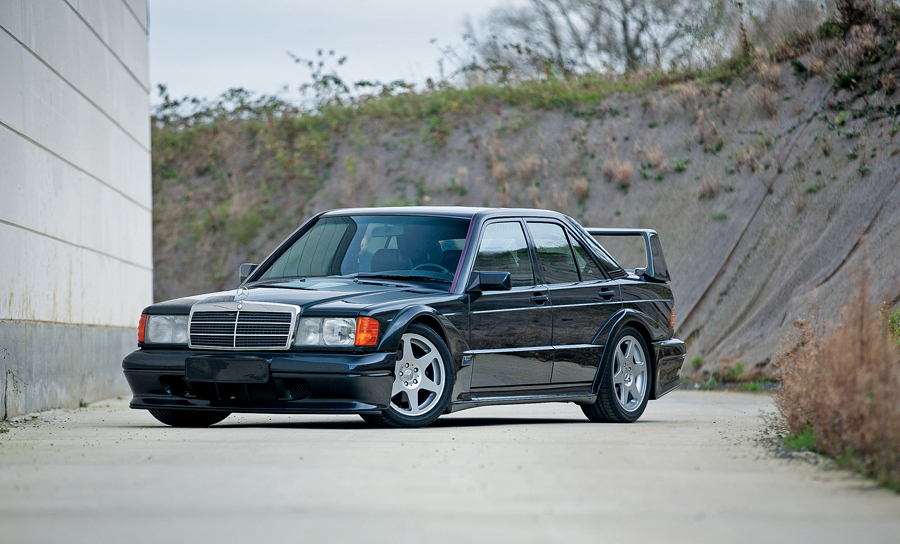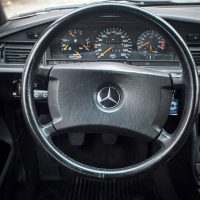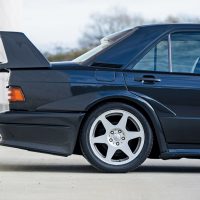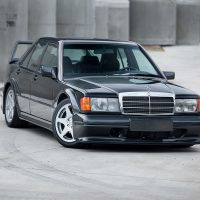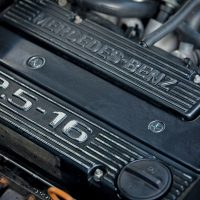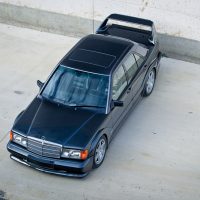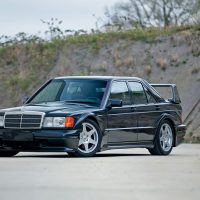SCM Analysis
Detailing
| Vehicle: | 1990 Mercedes-Benz 190E 2.6-16 Evolution Sports Saloon |
| Years Produced: | 1990 |
| Number Produced: | 502 |
| Original List Price: | $80,000 |
| SCM Valuation: | Median price, $17,900; high sale, $408,000 (for a car with just 1,723 miles on the clock) |
| Tune Up Cost: | $1,300 |
| Chassis Number Location: | On firewall directly in front of battery box |
| Engine Number Location: | On rear left side of engine block |
| Club Info: | 190 Revolution website |
| Website: | http://190rev.net |
| Alternatives: | 1990–92 Lotus Carlton, 1990–92 Ford Sierra RS Cosworth, 1992–94 Audi RS2 Avant |
| Investment Grade: | C |
This car, Lot 108, sold for $162,136, including buyer’s premium, at Bonham’s Mercedes-Benz sale in Stuttgart, Germany, on March 19, 2016.
As much as I would like to jump right into the mechanics of the 190E 2.5-16 Evo series, I think it would be fair to give you a brief history lesson. And for those of you who think I am going to be critical of the 190E’s rival from Munich, well, brace yourselves.
A true Teutonic blunt-force weapon
When Mercedes unleashed the 2.3-liter, 16-valve engine on the world at the end of 1983, they already knew that their trusty M102 engine could make 300 horsepower without blowing apart. The 2.3-16 gave way to the 2.5-16 in 1988.
The 2.5-liter engine was initially bored all the way out to 2,498 cc, as Mercedes resorted to its old habit of punching engines out to their limits. Even though this bigger version made 204 horsepower, it barely outperformed the old 2.3-liter. A thoughtful redesign yielded the slightly smaller Evo engine, but it took the genius of AMG to really make it produce more than 204 horses.
In 1990, the Evo 2 appeared, sporting the now-legendary AMG Power Pack with “about” 235 horsepower. While said Power Pack could be implemented into a normal 2.5, it worked best with the modified engine of the Evo 1 cars (where it was optional equipment), so Mercedes delivered all Evos with the Power Pack. But no two Mercedes engines are exactly the same, and that is especially true here.
Mercedes refuses to play the horses
Many longtime owners of Mercedes cars know something that few other drivers understand. This only makes sense when you are embarrassing drivers of modern SUVs in the right lane while mysteriously relaxing behind the wheel of your 125-horsepower 350SD and making short work of Vail Pass.
In 1990, Mercedes did not play the horsepower game, and if you judge the 2.5-16 by its power output, you are missing the point.
For starters, the numbers can’t be trusted, as Mercedes has always underrated the quoted horsepower ratings of their engines. The numbers that were emphasized were oriented towards more important attributes: longevity, absolute reliability, acceleration at mid-range speed, maximum sustained engine speed, oil volume delivery and other areas where certain manufacturers of performance cars are notoriously deficient.
Give me any healthy M102 16-valve engine, and I promise you that, with proper maintenance, it will survive relentless performance driving for hundreds of thousands of miles. When you are driving a car at the limit, the last question on your mind is, “How much horsepower do I have?” First and foremost, the driver worries about the durability of the engine, which is where Mercedes had its longtime rival from Munich beat.
All Cossies headed to a bright future
If you examine the facts, all of the Cossies (the nickname that the public has affectionately bestowed on 16-valve 190s) have disturbingly similar performance figures. Unless you are madly attached to that Evo body kit, a good European 2.3-16 valve performs almost as well as the Evo 2.
This means that for under $25,000, you can have as much fun as the person who purchased our subject car.
Values for good Cossies have certainly doubled in the past few years, and the durable nature of the car’s basic parts means that a high-mileage car can still be bought reasonably and sorted out. Unmodified cars will always perform best financially, so think twice before you remove the rear self-leveling suspension and add racing stripes.
I’m also going to tease you by mentioning that AMG shoehorned a 3.2-liter M103 6-cylinder engine into 200 190Es and sold them through Mercedes dealers in Europe with a full factory warranty. These 234-horsepower monsters could reach 162 mph — if you dared.
Evo 2 gets last laugh
Our subject Evo 2 was a textbook sale — fairly bought and sold — with future upward movement likely. The only obvious cosmetic flaw was some surface corrosion in the engine compartment on items that were originally plated in yellow zinc. Otherwise, it appeared to be a sound example.
While the documentation does not list a recent valve adjustment, this is a necessary procedure the new owner should undertake.
So what happened between the 190 and its foe from Munich? In 1992, after years of chasing BMW, the Evo 2 finally seized the DTM constructor’s title under the steady hands of Klaus Ludwig.
This was a significant victory for the aging Evo 2. Even more laudable was its ability to fend off the V8 Audis, which were using newer technology and had four-wheel drive. While the horsepower, drag coefficient and top speed were very close between the BMW M3 and the 190, there is something intrinsically stronger about the baby Benz that made it capable of maintaining competitiveness after three race seasons.
Much like a boxer who stands through the rounds, taking hit after hit, the 190 was still standing when its rival, the M3, was catching its breath. Even today, if you compare a 20-year-old BMW with a 30-year-old Mercedes, the Mercedes has the edge in build quality.
While the BMW E30 is a sturdy, solid car, and the Mercedes-Benz W201 has some questionable plastic parts, give me the Mercedes any day. Items such as wiring harnesses, transmissions, evaporators and suspension bushings just don’t lose integrity. What does this translate to? You get more enjoyment with fewer headaches, which is why classic Mercedes are great investments.
While there is no fitting eulogy for a machine as ridiculously brilliant as the 190E 2.5-16 Evo 2, the rising values of these cars are an appropriate testament to their excellence. My congratulations to the buyer for understanding that intrinsic value is the most important attribute in an automobile. ♦
(Introductory description courtesy of Bonhams.)
